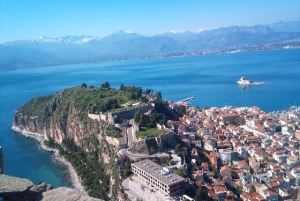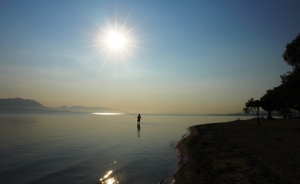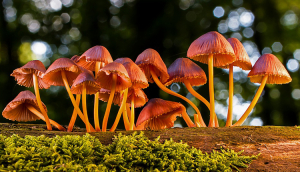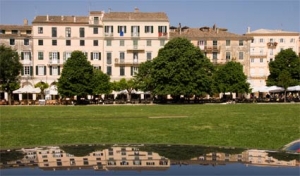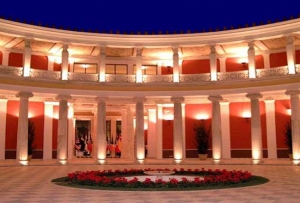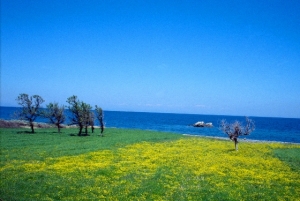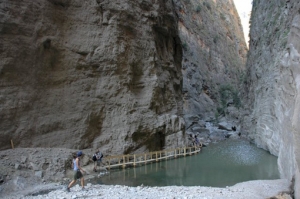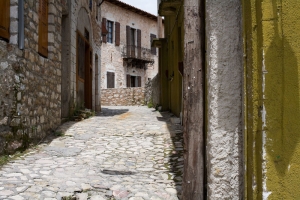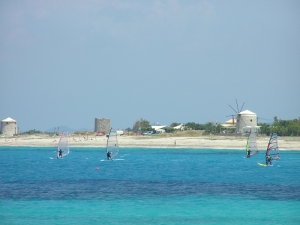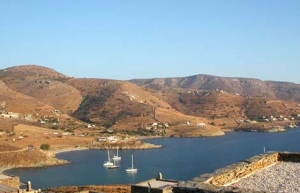According to the story, the Venetian architect Francisco Vitelli had to have more than 2,000 buildings demolished, mostly houses and churches, in order to gather the construction materials needed for its construction. However one of the prettiest Gates of the city, the Porta Reale, was also demolished.
As the centuries have passed, the Fortress has suffered many wounds. The people of Corfu themselves had to destroy a big part of it and most walls that connected it to the Old Fortress and which surrounded the city, after the Great Forces ordered them to, at the eve of the union of the Heptanese with Greece in 1864. However the tunnels that connected it to the Old Fortress are still preserved, although not open for the public.
To read more, please visit kerkyrainfo.gr
ABOUT US
XpatAthens
A 2-Day Road Trip To Peloponnese’s Ancient History
Let’s say you are visiting Greece and you don’t feel like going to the beach, probably because it’s not that warm any more or you’ve seen enough beaches so far. You’ve seen most of Athens and you have a couple of days to spend, two days full of history and beautiful landscapes. Then you just have to rent a car, get a map and history is all yours! First stop will be at Isthmus of Corinth (the Corinth Canal).
This man-made canal is the border between mainland Greece and Peloponnese. Ancient Greeks used to carry their ships through a narrow road in order to bypass this small part of land.
Following the direction to Tripolis, we make a turn when we see the sign Mycenae. In less than 2 hours from Athens lies the ancient city of Mycenae, one of the first empires in the ancient Greek times. You may have heard it from Iliad, the world famous epic poem by Homer. The king of Mycenae, Agamemnon, was considered to be the king of the kings in ancient Greece. His capital, the citadel of Mycenae, was one of the first organized cities, with high stone walls called Cyclopean Walls. Due to their huge size these walls are considered to have been built not by humans but by Cyclops. Enter the city by the Lion Gate. Also pay a visit to the Treasury of Atreus, a very famous and impressive “tholos” tomb. Same ticket applies for the citadel and the Treasury.
Heading to Nafplio, we make a stop to the Acropolis of Tiryns. It also used to be one of the well known citadels in ancient Greece – 2.000 years BC. Both Mycenae and Tiryns are included in UNESCO’s catalogue as Monuments of World Cultural Heritage.
Napflio is one of the most beautiful getaways from Athens. It was the first capital of Modern Greece. The old city is full of narrow roads, beautiful buildings, many hotels and restaurants. You can find low prices off-season. Pay a visit to the Rosary Museum (“Kompoloe” in Greek), a hidden gem in Napflio. If the weather is good, consider taking a boat to Bourtzi castle, a small castle in the middle of Napflion harbour. Enjoy a meal in one of the traditional tavernas in the old city of Nafplio. Try local, traditional and seasonal food like stuffed vegetables, fresh fish and salads. Nafplio is also famous for ice cream shops, some following famous gelato recipes directly from Italy.
Next day, after having a breakfast in the old city opposite to Bourtzi castle, it’s time to pay a visit to Epidaurus. It is located about half an hour from Nafplio. The archaeological site is full of surprises and history. Visit the Asklipeio, one of the most famous ancient ‘hospitals” – healing process for Greeks was a mixture between medicine, science and belief. The Asklipeio was considered to be the birthplace of Asclepius, the healer, god of medicine and healing.
The ancient theatre of Epidaurus is probably the most known ancient theatre of ancient Greece and is still in use. If it happens that you are around during summer, book a ticket to see a play in this really beautiful with perfect acoustic theatre. You may not understand the words, but you can feel them with your other senses. The spirit is still there.
Returning to Athens via the coastal road near the Saronic gulf, full of memories, pictures and ancient spirit, you may imagine how all these places created the foundation of modern civilization.
P.S.: Check the opening hours of the archaeological sites before visiting in order not to miss anything.
Text by: Christos Loukas (aka Kitsos Mitsos) - World traveller and blogger - www.blogtravels.gr
To read more, please see blog.visitgreece.gr
Winter Light In The Greek Islands
The light seems never to be full of Greek beauty. In winter, it is still there, bright as always but somewhat sweeter. It revives the winter colors, whilst the mild temperatures rejuvenate the desire for exploration of Greek beauty. If you believed that islands journey through the winter months in solitude, in the sea while reminiscing the lively summers, the time has come to be informed of the opposite.
Corfu, the cosmopolitan island
Where: The most northern island in the Ionian complex
Why: Stands out due to its refined Italian finesse and the cosmopolitan, Venetian character that impresses throughout the year. Renowned globally as the green island of the Feakes and Odysseus’s final stop before returning to his coveted destination, Ithaca. Corfu is one of the most beautiful islands in the Mediterranean, distinguished by its rich nature, as well as, wonderful attractions.
What to visit: The famous Old Town of Corfu, with the illustrious Esplanade, one of the prettiest piazza’s of Greece, with the Old Fortress on its East and a cricket court on the grounds. Walk through the prominent pathways and admire the unique estates. Enjoy a stroll through the beautiful Liston, adorned by elegant colonnades. Visit the imposing temple of Saint Spyridon, patron saint of the island, with the acclaimed crimson bell tower. Admire the palace of Saint Michael and Saint George, the only “Georgian” style monument in the Mediterranean and the masterpiece, Achilles, 19 kilometers southwest of the city. A trademark locale, is the small island known as Pontikonisi (Mouse island), the brightest gem on the Corfiot crown. We travel through time with Archaeological and Byzantine Museum’s and the Banknote Museum’s impressive exhibits. In the northern region, is the area of Paleokastritsa, known for Aggelokastro – the commanding remains of a Fortress – which along with Kalami and Kassiopi, are some of the most beautiful areas of the islands. While in the southern region you will be astounded by the traditional village of Vatos, as well as, the exquisite habitat of the Korission Lake.
Evia. Endless beauty
Where: Stretching across the northeastern coastline of continental Central Greece
Why: Near Athens and with very easy access, Evia is the second biggest island of Greece and the sixth largest in the Mediterranean. Despite its tourism, Evia’s charm remains intact, enchanting the senses. The numerous beautiful cities, combined with renowned locations and impressive attractions, make Evia the ideal destination, even during the winter season. Its rich geophysical scenery, surrounded by imposing mountains and beautiful lakes, offers visitors a plethora of activities, such as hiking, biking and horseback riding, thus keeping the momentum going at all times.
What to visit: Beautiful Chalkida, the capital of the island, where you can enjoy a stroll on the beach with a background of the famous bridge. You will be able to admire the Castle’s old quarters, distinguished by its architecture, characterized by Turkish and Venetian influences and impressed by the plethora of exhibits in the Archaeological and Folk Museum. The ancient city of Eretria is especially interesting, only 22 kilometers southeast of the Chalkida, which in ancient times was one of the most prestigious areas of Greece, before it’s destruction by the Persians in 490 B.C.
Karistos awaits you in the south of the island, 130 kilometers from Chalkida; a historic city, with beautiful neoclassical buildings, decorated by the exceptional Venetian port of Castelo Rosso. The harbor includes scenes of traditional cafes, picturesque taverns, as well as, restaurants offering gastronomical delicacies that appeal to all taste buds. You will also be able to horseback ride and hike in the beautiful nature and of course blaze your own biking trails. In the northern part of the island, tracing back to the depth of ancient Greece, you will encounter the baths of Edipsos, the most well-known health and wellness center in all of Greece. Also in the north, the settlement of Kimi, with a spectacular view of the sea, is one of the prettiest in the region.
To read more, please see visitgreece.gr
Grevena, The Mushroom Capital Of Greece
Do you know why Grevena is called "The land of the mushrooms"? Because in the area grow more that 1.300 mushroom species! Whether you are a mushroom lover or a gourmet specialist, in Grevena you will savor the most imaginative dishes, hot mushroom soups and tasty mushroom pies cooked with wild, cultivated, powdered or dried mushrooms, and sprinkled with mushroom liquor or mushroom sauces!
Get to know the city better by taking romantic strolls along the river Grevenitis. Wander around Grevena's main squares: Eleftherias where you can admire the clock tower, the landmark of the city, and Aimilianou, where you will feel the pulse of the city’s nightlife!
Visit the Central Public Library to find historical documents on Grevena; the Boussios Mill, an exceptionally restored 19th century flour mill; the Municipal Museum which houses elephant and wild ox fossils, as well as folklore exhibits, and the Metropolitan church which hosts the ecclesiastic museum.
Welcome the opportunity to visit the nearby village Milia. The Natural History Museum there boasts a rare palaeontology collection which actually shows the largest mastodon tusks in the world, officially entered in the Guinness book of records!
Return to Grevena in August to attend the "Pan-Hellenic Mushroom Feast" organized by the “Mushroom Friends of Western Macedonia” on the banks of Venetikos river. A perfect occasion to visit the city would also be during the traditional carnival celebrations, the so-called “Anakatosaria”, that take place every February. Your trip to Grevena concludes with a half-day excursion to Mastorohoria, a beautiful complex of 25 outstanding stone villages nestled inside the dense oak-tree forest.
Source: Visitgreece.gr
Corfu Island - New Fortress
The New Fortress of Corfu (Fortezza Nuova) that lies on the hill of Saint Marcus, was built by Venetians on the 16th century, when the need to protect the city became imperative and the Old Fortress could no longer provide safety. Its construction started in 1576 and it was finished in 1645, although since then plenty of reforms and extensions have been made. It is built on two levels so it can correspond to its double function: to protect the port and to control the hinterland.
Best Archaeological Museums To Visit In Greece
National Archaeological Museum of Athens - The museum houses some of the best examples of Greek art. Artifacts from prehistoric Greece all the way up to Roman times are exhibited in its halls. Highlights include a large collection of Mycenaean artifacts, archaic Kouros statues, and masterpieces from the Classical and Hellenistic eras. This is by far the largest museum of Greece, and it shelters the best examples of Greek Art and Culture from the entire country.
The building has been recently renovated in 2004, and some of its collections have been enhanced.
The Acropolis Museum (at the Acropolis of Athens)
A visit to the Acropolis should include a visit to the Museum on the site. If you love art, the Acropolis museum will not disappoint with its exhibition of mostly Archaic and Classical sculptures from the various Acropolis monuments. The highlights are the parthenon freeze, a large collection of Kouros and Kore statues, and the original Caryatides statues from the Erectheon. Now if the British government could return the Elgin marbles from London, one would be able to experience the entire Acropolis site in one visit.
Heraklion Museum in Crete
The best examples of Minoan art and culture have been collected in the Heraklion museum in Crete. Minoan civilization has been widely credited as the first European civilization and the artifacts it produced are dazzling in their quality. Highlights of the Heraklion museum include the Bull rython, the gold jewelry from Malia, and the beautiful frescoes from the palace of Knossos. Examples from the classical and Hellenistic periods are also exhibited at the museum.
Olympia Museum
The museum at ancient Olympia is a great place to spend a whole day strolling through its collection. Recently renovated in 2004, it is a pleasant building that shelters some of the best examples of ancient Greek Classical and Late Classical Greek art. Most visitors will marvel at Hermes of Praxiteles, and most art scholars will drool over the statues from the Temple of Zeus pediment and metopes.
Delphi Museum (from ancient-greece.org)
The museum at the ancient archaeological site of Delphi houses artifacts found during excavations at the site and should not be missed if you travel to Greece. Highlights of the museum include the "Charioteer of Delphi", a bronze statue of the severe style, and the two archaic Kouroi named Kleobis and Biton. Since the oracle of Delphi was so important for the politics of the entire Eastern Mediterranean, it was adorned by the best examples of art in ancient times, many of which have been unearthed and are now housed in the museum.
Museum of Prehistoric Art (in Santorini)
I visited the Museum of Prehistoric Art during my visit in Santorini, and I marveled at the variety and quality of its collection. While most travelers think mainly of the Classical and Hellenistic periods of Greek art and culture, there is a whole world of prehistoric art to be discovered in museums like this one. It houses a great deal of artifacts from the excavations at ancient Akrotiri, and its highlights include reconstructions of ancient houses with frescoes of joyous human and animal activity.
Vergina Royal Tomb
The royal tomb of Vergina have been renovated recently to become one of the most spectacular museums / archaeological sites of Greece. The rounded hillock, known as the Great Tumulus was created in ancient Greece to protect the tomb of the Macedonian king Philip II, father of Alexander the Great and others. Today, visitors who enter the tumulus enjoy an excellent exhibit of the artifacts found in the royal tombs alongside the tombs themselves. It is a great example of how the presentation of the artifacts in proximity to their original context allows for a unique experience and the best level of understanding.
Source: Greeklandscapes.com
Samothrace
The island of Samothrace in the north Aegean Sea is known for its wild, virgin natural beauty. Mt. Saos highest peak, called Fengari (the moon, in Greek) with its 1.611 meters (5.285 feet) is the second highest peak of the Aegean, second only to Psiloritis on Crete and is often covered with snow in winter months. Poseidon watched the Trojan War seated on this high peak, as Homer mentions. Mt. Saos, once an active volcano, has been recently included in the European Mountaineering Path.
It is rare to find any other Greek island which combines so many water springs, is rich in flora, with plane trees, oaks, olives, scent of oregano and thyme, hundreds of goats grazing wild, clean desert shores with cliffs, sea caves, streams, waterfalls and dramatic volcanic scenery at the same time.
Samothrace has recently received the International Quality Coast Gold Award for 2012, among 100 destinations worldwide, for its efforts to achieve good standards in sustainable tourism and for excellence in the categories of nature and identity.
The landscapes one encounters in the north and eastern parts of Samothrace are very different from the ones in the south and western part. There’s no road to drive to all parts of the island, so the visitor can alternatively take the boat trip running in the summer months to see and visit the isolated virgin shores. The coasts are very clean, mostly covered with pebbles. On the island’s southern part a dirt road leads to Pachia Ammos beach to the south, the most visited one, covered with golden sand. There one can reach the chapel of Panagia Krimniotissa, high on the steep cliff, dominating the area. The dramatic shore of Kipoi at the end of the road to the east, with dark volcanic gray and black pebbles reveals one of Samothrace’s secret beauties.
Paliapolis, one of the most beautiful and important archaeological sites of Greece, is located where the ancient capital and once the main seaport of the island used to be, on the northern coast. As a mystical centre in antiquity, it attracted thousands of pilgrims, among them famous personalities, who came to be initiated to the Mysteries of Kabeiroi in order to ensure a happy life after death. It was the island’s famed religious centre for centuries, where the ruins of the ancient city and of the Sanctuary of Great Gods survive in a Delphic landscape with plane-trees and oleanders. The visitor can also see some of the finds, discovered by French, Austrian, American and Greeks in a period of almost 150 years’ excavations, at the site’s small Museum. The most famous discovery was the renowned statue of Nike of Samothrace – the winged Victory goddess – kept in the Louvre Museum since 1863.
The island’s modern port and biggest settlement is Kamariotissa. The capital town is Chora, a traditional listed under protection settlement, built on the mountain slope in the 15th century like an amphitheatre, at an altitude of 300 m., between the slopes of Mt. Saos. It has two-storey stone houses with tiled roofs, paved squares and beautiful cobbled roads, free of cars. There, the Church of the Assumption of the Virgin Mary (1875), the Folklore Museum and the ruins of the medieval Castle, constructed by the Genovese Gattilusi family around 1400.
With its 999 chapels and churches, the island’s religious festivals attract many visitors from the mainland, reviving the local customs, with traditional music, dances and gastronomy. Not to be missed, is the delicious Samothracian goat, cooked in many different ways in the tavernas all over the island and the fresh fish brought by the boats to Kamariotissa port every morning.
Author: Efi Kalamboukidou-Paschali
Licensed Tourist Guide
& Conservator of Antiquities
Author of travel guide book
“Samothrace, History-Archaeology-Touring”
Source: visitgreece.gr
Discovering The Natural Wealth Of The Gorge Of Samaria
As they walk through the gorge, visitors are often stunned by the dense vegetation around them: towering pine trees and ancient cypress trees with massive horizontal branches stand proud on the slopes. At higher altitudes there are forests of maple, and where moisture is more plentiful, there are sycamore, oleander and willow trees.
In the National Park area there are more than 450 species of plant, 70 of which are species and sub-species native to Crete, such as Cretan dittany (Amaracus dictamnus – a type of mint), Ebenus cretica - a species of perennial flowering plant of the Fabaceae family, zelkova (Zelkova abelicea) and the Cretan Pine (Pinus brutia cretica).
Some of the plants, such as Bupleurum kakiskalae, a species of flowering plant of the Apiaceae family, Myosotis refracta refracta (a type of forget-me-not) and the orchid Cephalanthera cucculata are found only in the gorge. An idea of the natural wealth of the gorge is given by the fact that no one is yet sure precisely how many species actually exist within it.
There is also, of course, an impressive array of fauna in the gorge, which is home to a host of species and sub-species which are exclusive or almost exclusive to Crete (32 species of mammal, 3 species of amphibian, 11 species of reptile and around 200 species of bird).
To read more, please see visitgreece.gr
Dimitsana
Dimitsana (Δημητσάνα) is well known in Greece as a popular winter destination but is certainly not on the radar of the majority of foreign tourists. It is located 3 hours by car from Athens in the Peloponnesian district of Arkadia and at an altitude of 1000 meters, which means it can see a fair bit of snow during the winter months.
Dimitsana’s stone built houses, lovely mountain scenery and its history as the engine of the Greek independence movement in the early 1800s make it a fascinating place to spend a few days.
Things to do in Dimitsana
Dimitsana was a commercial center in the 18th century and flourished during the years up to and including the Greek war of independence in 1821. Its position on the Lousios Gorge meant that water was available to power mills that were involved in the production of flour, animal skins, metal works and (most importantly) gunpowder. Without the gunpowder mills of Dimitsana (evidence suggests up to 14 operated in the village and surroundings) the Greek freedom fighters would have been doing a lot less fighting. The Lousios Gorge also hides a number of secluded monasteries along its walls that became centers of resistance and education during those years. A number of celebrated Greek resistance fighters and Patriarchs made their home in Dimitsana and/or the nearby monasteries and today Dimitsana is home to two small museums celebrating its illustrious past, the Ecclesiastical Museum and the Town Library.
Ecclesiastical Museum
Dimitsana’s own homegrown son is none other than Ecumenical Patriarch of Constantinople, Grigorios V. His house just off the main street has been restored and made into an Ecclesiastical museum holding treasures from the churches of Dimitsana and the surrounding monasteries. Most pieces are from the eighteenth and nineteenth centuries and include a several representative sample of icons produced by seventeenth century artists in Crete. Take note, the museum is only open Saturday and Sunday in the winter time 09:30 – 13:30.
To read more, please visit travelsingreece.com
Things To Do In Lefkada
Events
• International Folklore Festival. As of 1962, bands and artists from all over the world meet in Lefkada every August and exchange the product of their cultural and artistic folklore in the fields of dancing, music, and traditional heritage.
• The Discourse & Art Festival. It has been organised by the Cultural Centre of Lefkada and involves theatrical and musical events, exhibitions, conferences, and poetry nights. It is one of Greece’s oldest cultural institutions along with the Athens Festival.
• Wine festival that takes place in Sfakiotes Municipality on Frya Square, around the historic Frya Well.
• Representation of a traditional wedding in Karya (August 11th).
Activities
• Swimming. If you stay in Lefkada town, you can swim at Kastro, Gyra, Myloi, and Agios Ioannis Antzousis. You will discover there are amazing beaches almost everywhere and to the island’s east you will find numerous beautiful, wooded isles.
• Visiting the sea caves. Kalamos and Kastos isles are within a short distance and can boast beaches and sea caves of great beauty.
• Bicycling; the town of Lefkada as well as the nearby coastline are ideal for a bicycle ride. Go round the lagoon, following the exceptional scenic route: Agia Mavra – Gyra – Myloi – Ai Giannis – Lefkada.
• Marina: it is located at the town’s east side, and is considered to be the best equipped marina in Greece.
Sports
• Kite surfing in Myloi beach.
• Mountain biking: the island’s tall, green mountains are criss-crossed by routes and trails that are ideal for this sport. Rent your mountain bike in Lefkada town.
• Paragliding (parapente) over Kathisma beach.
Visit also:
• Kariotes, a seaside village with modern tourist facilities, lying on the island’s east shores. At “Spasmeni Vrysi” location there is a well equipped camping site.
• Nikiana, a picturesque fishing village, built at the foot of Mount Skaros near a forest of age-long oak trees.
• Nydri. The island’s biggest tourist resort can boast an intense nightlife and an ultra-modern marina. Nydri faces Prigkiponisia (i.e. Madouri, Cheloni, Skorpios, Skorpidi and Sparti islands). There is a ferryboat service running to Meganisi, Ithaca, Kefalonia and Central Greece. You can go scuba diving; try one of the local scuba diving centres that organise underwater explorations. You can also opt for other water sports such as sailing or choose mountain biking, hiking, even swimming at the waterfalls cascading in Dimosari ravine.
• Poros, the southeastern Lefkada’s “balcony” offering a fine view of Arkoudi, Oxies, Ithaca, and Kefalonia islands. Swim in the crystal-clear waters of Mikros Gialos, where you can also find a well-equipped camping site.
• Vasiliki is a place with abundantly flowing waters and a vibrating nightlife. Take the ferry for a visit to the captivating Porto Katsiki beach, Agiofylli beach, Kefalonia and Ithaca. Vasiliki bay is a destination widely known for the particular climate conditions and favourable winds that make it very popular among windsurfing fans. You will also find horse riding farms that organise outings on horseback in the country.
• The lighthouse (within a short distance from Athani village) and the ruins of Apollo’s sanctuary in cape Doukato (Lefkata or Cape Kyra). That breathtaking location of rugged cliffs and magnificent sea view is also known as “Sappho’s Jump”; legend has it that this was the spot where Sappho, the lyric poetess of antiquity jumped off from, taking her own life.
• Agios Nikitas, a beautiful seaside village.
• Karya, a well known mountain village with a picturesque plane tree shaded square. The exquisitely crafted traditional “karsanika” embroideries have won the place a fine reputation.
• Egklouvi, another beautiful traditional mountain village. It is famous for producing delicious lentils that are one of the top varieties in Greece. Other cultivations include chickpeas, broad fava beans, and a rare grape variety called “vertzami” possibly introduced to the area by the Venetians in 1684.
Nearby islands
1. Meganisi
Ferry runs connect this green island to Nydri. There are three traditional villages, namely Katomeri, Vathy and Spartochori. Visit Giovani’s Cave and Papanikolis Cave, (accessible only by sea).
2. Kalamos
Kalamos Island is covered with pine trees, especially the north part. There is a ferry connection with Mytikas, Central Greece. Visit Episkopi, Kastromonastiro and Porto Leone, a small scenic bay.
3. Kastos
Kastos is an elongated isle covered in olive trees. It provides safe anchorage for boats sailing the Ionian Sea. There are very few roads on the island, so there are no cars. Sarakiniko, the island’s west natural bay has a small jetty that allows mooring even during bad weather. There is a small shuttle boat service running to Central Greece. Visit Kastos village, Fokotrypa and Agios Aimilianos country chapel.
Source: Visitgreece.gr and lefkada.org.uk
Sightseeing On Kea
The serene island of Tzia is an island with striking landscapes, stunningly beautiful beaches, picturesque villages and winding paved alleys exuding peace and tranquillity. In spite of being the capital of the island, Ioulida or Chora is a traditional village reflecting the island’s spirit with donkeys used for transportation and central squares dotted with cafes and restaurants.
The Kastro (Castle), with the remains of the Venetian wall and acropolis, the church of Agia Paraskevi, the Episcopi Monastery, the Archeological Museum hosting ancient artifacts from excavations that took place on the island are also sites that one must visit as well as the neoclassical buildings of the city hall and the school, the Agia Anna Monastery, the Church and Tower of Agia Marina and the Cathedral of the Annunciation.
The Lion of Kea in Ioulida
This is an archaic statue curved out of stone resembling the lion that chased off the water nymphs according to the Mythology. According to the myths, when the nymphs inhabited the island they started killing the women. The people wanted to abandon the area but a priest of Zeus prayed to the God and he sent a lion to drive away the nymphs. And so it was done. The inhabitants then carved a lion in the rock so that the nymphs would see it and get scared. This is the Lion of Kea…a dive into mythology!
To read more, please visit cycladia.com

